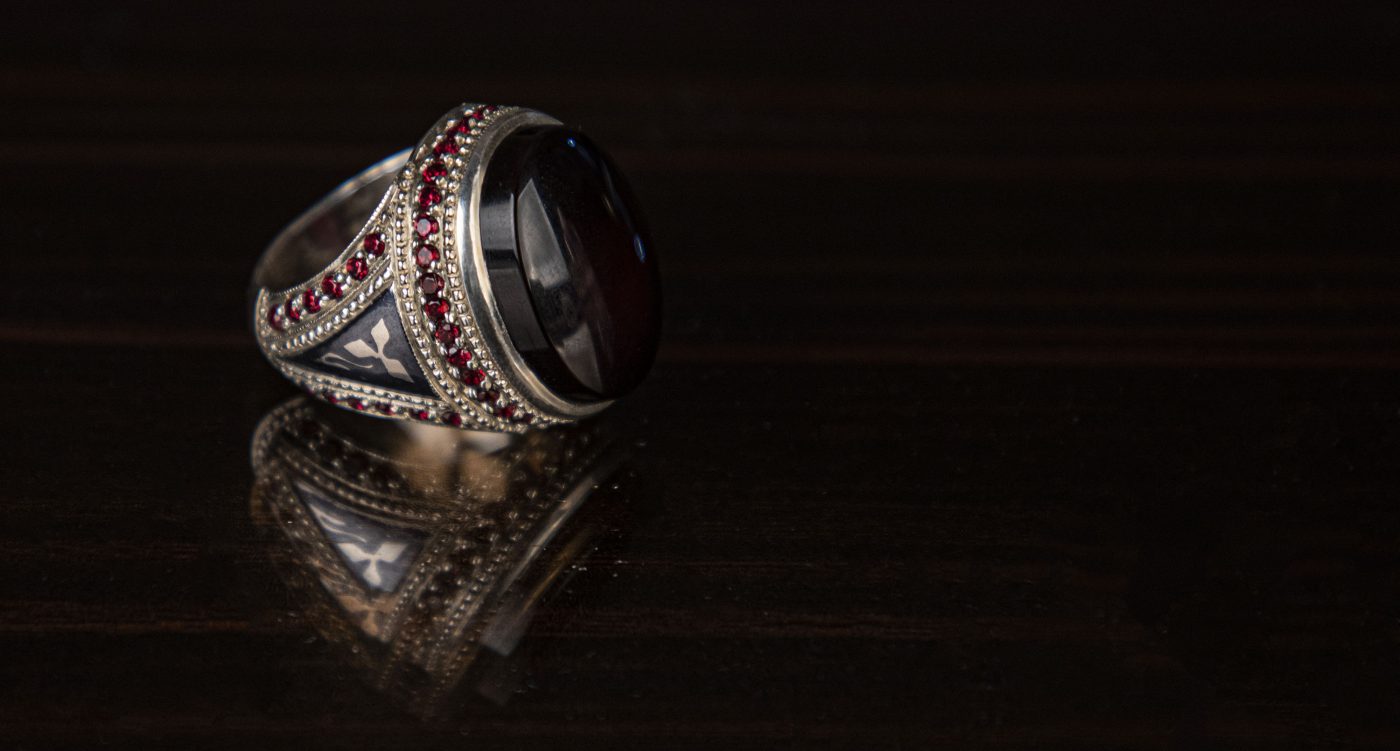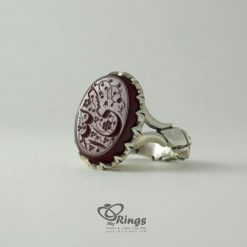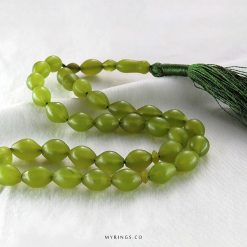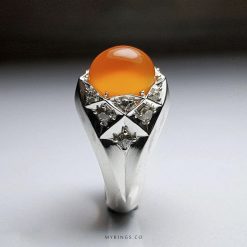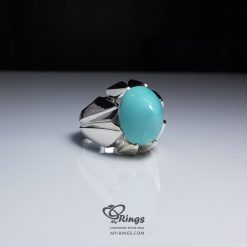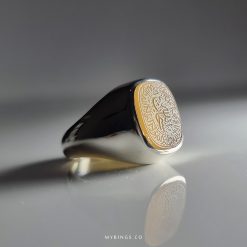Blog
Every Things About Silver Ring
What is sterling silver?
Sterling silver is a popular and widely used precious metal alloy in jewelry and silverware. It is composed of 92.5% pure silver and 7.5% of other metals, typically copper. The term “sterling” originated in England in the 12th century, when it referred to the highest standard of silver coinage. Over time, the term extended to encompass the 92.5% silver alloy used in various silver items.
The addition of copper or other metals to pure silver serves multiple purposes. Firstly, it enhances the strength and durability of the metal, making it more suitable for everyday wear. Pure silver on its own is relatively soft and malleable, so the addition of other metals provides structural integrity. Secondly, the presence of other metals can contribute to desirable characteristics such as improved luster, tarnish resistance, and better casting properties.
Sterling silver is recognized worldwide as a valuable and versatile material for jewelry, flatware, decorative items, and more. It is often marked with the hallmark “925” or “sterling” to indicate its silver content. This precious metal alloy combines beauty, durability, and affordability, making it a popular choice for a wide range of silver creations.
Sterling Silver vs. 925 Silver
Sterling silver and 925 silver are essentially the same thing. The term “sterling silver” refers to a silver alloy that contains 92.5% silver and 7.5% of other metals, typically copper. This is why sterling silver is sometimes referred to as “925 silver,” as it contains 925 parts per thousand of pure silver. The addition of other metals, like copper, helps to improve the strength, durability, and overall quality of the silver, making it suitable for jewelry and other decorative items. Therefore, there is no actual difference between sterling silver and 925 silver; they are just different names used to describe the same silver alloy composition.
What is the benefits of silver ring?
Overall, the benefits of silver rings encompass their enduring beauty, versatility, durability, hypoallergenic properties, affordability, ease of maintenance, and the symbolic meanings they can hold.
How to distinguish real silver from fake?
To distinguish real silver from fake, utilize a combination of methods. First, look for hallmarks on the item, such as 925 for sterling silver, indicating its purity. Next, perform the magnet test (authentic silver is not magnetic), so if a magnet strongly attracts the item, it’s likely not genuine. Conduct a visual inspection, noting the shine and tarnish (real silver has a distinct luster and develops a darker patina over time). Compare the weight, as genuine silver tends to be denser and heavier than fakes. When in doubt, consult a professional jeweler or silver expert for a thorough assessment.
Guide to Finding The Ring Size
To check your ring size, you can use a ring sizing chart, measure with a string or paper, use a ring sizing tool, or visit a jewelry store for professional assistance.
Discover Your Perfect Fit: A Guide to Finding Your Ring Size
To check your ring size, you can try the following methods:
-
Use a Ring Sizing Chart: Many jewelry stores and online retailers provide ring sizing charts that you can print out. These charts typically consist of circles with different diameters representing various ring sizes. You can place one of your existing rings on the circles to find the closest match.
To check our guidance and size chart: Click Here -
Measure with a String or Strip of Paper: Take a piece of string or a strip of paper and wrap it around the base of the finger where you plan to wear the ring. Make sure it’s snug but not too tight. Mark the point where the string or paper overlaps, and then measure the length with a ruler. Match the measurement to a ring sizing chart to determine your ring size.
-
Use a Ring Sizing Tool: You can purchase a plastic or metal ring sizing tool, also known as a ring sizer or mandrel. It typically consists of a series of rings marked with different sizes. Simply slide the rings onto your finger until you find the one that fits comfortably.
-
Visit a Jewelry Store: Professional jewelers have ring sizing tools and can accurately measure your ring size. Visit a local jewelry store and ask them to measure your finger. They may have various sizing options available to ensure an accurate fit.
Remember that it’s best to measure your ring size at different times of the day since our fingers can vary slightly in size due to factors such as temperature and water retention.
To know more things about ring size check Wikipedia
Some of benefits of silver ring?
Silver rings offer several benefits that make them a popular choice for jewelry. Here are some of the key benefits of wearing silver rings:
-
Timeless Beauty: Silver has a naturally lustrous and captivating appearance that never goes out of style. It adds a touch of elegance and sophistication to any outfit, making it suitable for both formal and casual occasions.
-
Versatility: Silver rings come in a wide range of styles, designs, and finishes, offering versatility to suit different personal preferences and fashion trends. Whether you prefer a simple band, a statement piece, or an intricately detailed design, there’s a silver ring to match your style.
-
Durability: Silver, particularly sterling silver, is known for its durability and longevity. It is a relatively hard metal that can withstand everyday wear and tear, making it suitable for rings that are worn regularly.
-
Hypoallergenic Properties: Many people with sensitive skin or metal allergies find silver rings to be a comfortable option. Silver, especially sterling silver, is generally hypoallergenic, making it less likely to cause skin irritations or allergic reactions.
-
Affordability: Compared to other precious metals like gold or platinum, silver rings are often more affordable while still offering an elegant and luxurious look. This makes silver rings a cost-effective choice for those looking for high-quality jewelry within a budget.
-
Easy Maintenance: Silver rings are relatively easy to care for. Regular cleaning with a soft cloth and mild cleaning solution can help maintain their shine and prevent tarnishing. Additionally, silver rings can be easily resized or repaired if needed.
-
Symbolic Meaning: Silver has been associated with various symbolic meanings throughout history and across different cultures. It is often associated with qualities such as purity, clarity, and emotional balance, adding sentimental value to silver rings as meaningful gifts or personal accessories.
Overall, the benefits of silver rings encompass their enduring beauty, versatility, durability, hypoallergenic properties, affordability, ease of maintenance, and the symbolic meanings they can hold.
The Magic of Silversmithing: Crafting a Handmade Silver Ring
Original vs. Fake silver?
Distinguishing real silver from fake can be a bit tricky, but here are some methods that can help you determine the authenticity of silver:
-
Look for Hallmarks: Genuine silver items often have hallmarks stamped on them. These marks indicate the silver’s purity or fineness. In the United States, the most common hallmark for sterling silver is “925,” indicating that it contains 92.5% pure silver. Other countries may have different hallmarks, so it’s important to research the specific markings used in your region.
-
Perform the Magnet Test: Silver is not magnetic, so if a magnet attracts the item strongly, it is likely not made of real silver. However, keep in mind that some counterfeit items may be made with non-magnetic metals that mimic the appearance of silver, so this test is not foolproof.
-
Conduct a Visual Inspection: Genuine silver has a distinct shine and luster. If an item appears too shiny or reflective, it could be a sign of a fake silver coating. Look for signs of tarnish, as real silver tarnishes over time, developing a darker patina. If the item appears too bright or doesn’t tarnish at all, it might not be authentic silver.
-
Perform a Weight Comparison: Silver is a dense metal, so authentic silver items will generally feel heavier compared to fake ones. If an item that is supposed to be made of silver feels unusually light, it may be an indicator of it being counterfeit.
-
Seek Professional Assessment: If you’re still unsure about the authenticity of a silver item, consult with a professional jeweler or silver expert. They have the knowledge and experience to examine the piece using various techniques and instruments to determine its authenticity accurately.
Remember that these methods are not foolproof, and it’s always best to consult with an expert if you have concerns about the authenticity of a silver item.
Gold vs. Silver: Exploring the Differences and Choosing the Perfect Metal for Your Style
The choice between gold and silver ultimately depends on personal preferences, style, and individual circumstances. Both gold and silver have unique qualities and characteristics that make them appealing to different people. Here are some factors to consider:
-
Value and Rarity: Gold is generally considered more valuable than silver due to its scarcity and historical significance. It has been a symbol of wealth and luxury for centuries. However, the value of both gold and silver can fluctuate in response to market conditions.
-
Aesthetics: Gold and silver have distinct visual properties. Gold has a warm, rich, and luxurious appearance, while silver has a cool, bright, and versatile appeal. The choice between the two metals often comes down to personal taste and the desired look.
-
Durability: Gold is a relatively durable metal that resists tarnishing and corrosion. However, pure gold (24 karats) is soft and may be prone to scratching or bending. Silver, particularly sterling silver (92.5% pure silver), is also durable but can tarnish over time. It is generally stronger than pure gold.
-
Allergies and Sensitivities: Some individuals may be allergic or sensitive to certain metals. Silver, especially sterling silver, is often considered hypoallergenic and suitable for those with sensitive skin. Gold allergies are rare but can occur in some individuals, usually due to impurities in the gold rather than the metal itself.
-
Versatility: Silver is known for its versatility and ability to complement a wide range of styles and colors. It can be dressed up or down, making it suitable for various occasions. Gold, particularly yellow or rose gold, is often associated with formal or luxurious settings.
-
Price and Affordability: Silver is generally more affordable than gold, making it a popular choice for those on a budget or looking for more accessible options. However, the price of both metals can vary based on factors such as purity, weight, and market conditions.
Ultimately, the decision between gold and silver comes down to personal preference, style, and budget. Some people prefer the timeless elegance of gold, while others appreciate the versatility and affordability of silver. Consider your individual tastes, lifestyle, and desired aesthetics to make the choice that best suits you.
silver rings collections
